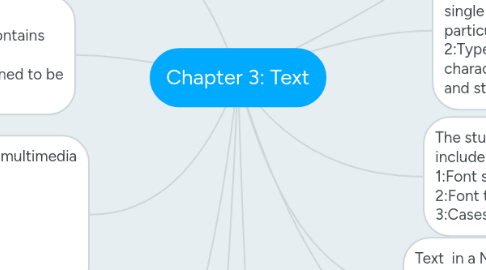Chapter 3: Text
CheeHwee Siewにより

1. Font Terminology: 1:Baseline 2:Cap height 3:x-height 4:Ascenders/descenders 5:Kerning 6:Tracking
2. Serif versus sans serif: A serif is the little decoration at the end of a letter stroke. Serif fonts are used for printed media or documents that have large quantities of text. Sans serif fonts do not have decoration at the end of a letter stroke. Sans serif fonts are used for headlines and bold statements. It is considered better for computer displays.
3. The text elements used in multimedia are: 1:Menus for navigation 2:Interactive buttons 3:Fields for reading 4:HTML documents 5:Symbols and icons
4. Bitmap vs Vector: i: Vector fonts drawing use instructions and mathematical formulae to describe each glyph ii: Bitmaps font consist of a matrix of dots or pixels representing the image.
5. Hypertext vs Hypermedia 1:Hypertext is a text which contains links to other texts. 2:Hypermedia is not constrained to be text-based.
6. Hypermedia structures 1:Links 2:Nodes 3:Anchors
7. Fonts and Typefaces 1:Font is a collection of characters of a single size and style belonging to a particular typeface family. 2:Typeface is a family of graphic characters, often with many type sizes and styles.
8. Text in a Multimedia Presentation: Text is obviously the simplest of data types and requires the least amount of storage.
9. The study of fonts and typefaces includes the following: 1:Font styles 2:Font terminology 3:Cases
10. Font styles include: 1:Boldface 2:Italic 3:Underlining 4:Outlining
11. Hypertext systems are used for: 1:Electronic publishing and reference works 2:Technical documentation 3:Educational courseware 4:Interactive kiosks 5:Electronic catalogs


